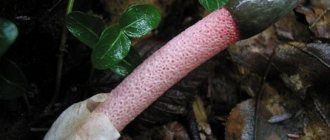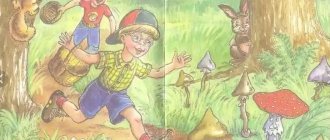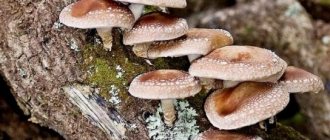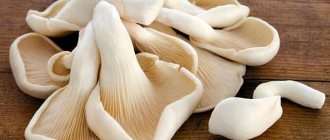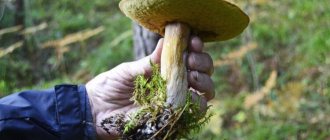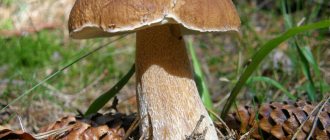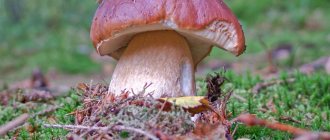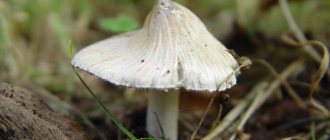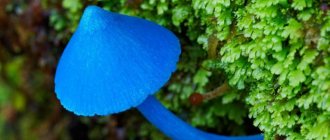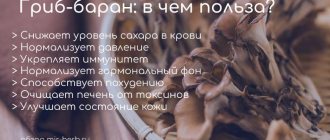Mutinus ravenella or "stinky morel" is a very rare, eccentric mushroom. The fruiting body of the specimen has an unusual appearance, and when it is broken, you can smell an unpleasant, unlike anything else. In its shape, the mushroom is unlike typical representatives of the kingdom. Thanks to this, when they encounter it in the forest, novice mushroom pickers get lost and cannot classify the specimen they find.
Description
The species is poorly studied. It is rare and even during the times of the RSFSR it was listed in the Red Books of several regions of Russia. The specimen was first described in 1888.
You can recognize this unique individual simply by the following characteristics:
| Part of a mushroom | Characteristic |
| Hat. | Absent. The fruiting body emerges from an egg with a diameter of 3 centimeters. It has two cavities that break and give way to the leg. |
| Leg. | Reaches 8-10 centimeters in height. Diameter no more than 1.5 centimeters. The end of the stalk has a pointed red tip. Hollow inside. |
| Controversy. | They have an olive tint. When rubbed in your hands, they emit an extremely unpleasant rotten odor. They are located right at the top of the leg. |
| Pulp. | Very smooth, delicate, has pores. |
The individual itself has no odor. The spores of the fruiting body in the form of mucus have a rotten hue.
Mutinus does not form mycorrhiza with trees. But if the summer is dry, the specimen can give up its moisture to the plants next to which it grows.
Time and place of fruiting
The fruiting period of mutinus begins in the second half of June and lasts until mid-September. For a full-fledged life, the mushroom requires soil generously saturated with humus. The main habitats of the fetus are:
- deciduous plantings;
- gardens;
- shrubs;
- thicket.
On a note!
You need to look for these mushrooms in damp soil, as well as near rotting wood. They appear abundantly in damp, foggy weather, as well as after long or heavy rains. The fruits grow in the same places every year.
In medicine
Mutinus ravenel is considered a medicinal species. It has long been used in medicine. Tinctures and decoctions were prepared from it. The specimen is still used in folk medicine today.
- For ulcers, colitis, gastritis, erosions and other gastrointestinal diseases. It is believed that this species helps heal the mucous membranes of human internal organs. The species improves peristalsis and helps people suffering from intestinal sluggishness.
- For pressure surges and hypertension, the mushroom is also used. It is able to normalize blood pressure and improve the functioning of the vascular system. It strengthens and restores the body's vascular network and can be used for thrombosis.
- The specimen is considered especially effective in the treatment of diseases of the musculoskeletal system. Can be used for gout, arthritis and arthrosis. Also in ancient times, the product was taken to improve joint function in old age.
- Almost all urinary tract diseases can be effectively treated with mutinus. Most often, tinctures from this type of mushroom are used to treat cystitis, pyelonephritis, and prostatitis. The specimen has also proven itself well as a means to improve male potency.
- Mutinus is used by traditional healers to improve the body's immune resistance. The body becomes more resistant to viruses and fungi.
- In folk medicine, the species is considered an aphrodisiac. Scientists have studied its composition and discovered substances reminiscent of male hormones.
Despite the wide range of beneficial properties, the use of mutinus ravenel in tinctures is very dangerous. The fungus can harm the body and lead to severe poisoning.
Taste assessment
Mutinus Ravenel has practically no pulp; the stem is hollow inside. Considering that this mushroom can be considered a plant “scavenger,” it is unlikely that anyone will have the desire to try it, and the number of flies nearby will scare away even the most daring discoverer from using it.
Interesting! It is believed that in the egg stage the mushroom is edible, but for this you need to have a very good understanding of the varieties, since a pale grebe can emerge from such a whitish cocoon, and this is already a deadly poisonous species.
Mutinus canis
This type of mushroom is practically no different from Mutinus ravenel. Externally, the mushrooms are almost completely identical. Canine mutinus is often used for therapeutic purposes, but is not eaten.
Dog mushroom is a natural antioxidant. It is believed that its effect on the body is extremely positive. It helps improve overall well-being and vigor. Increases performance and improves mood.
The composition of the specimen has not been studied thoroughly. Our ancestors used the juice of this species to prevent age-related diseases and prolong human youth.
Today, almost no attention is paid to this type of mutinus. Mushroom pickers do not collect it, for fear of confusing it with mutinus ravenel. But if you thoroughly know the external characteristics of an individual, then collecting it is not prohibited. When properly prepared, the product can be used as a natural medicine to improve body tone and immune resistance.
Description
This mushroom of the Veselkov family can be eaten only at a certain stage of its life cycle. Canine mutinus is absolutely safe and edible during the ripening period, while it is in an egg-shaped shell. The characteristic features of the fruiting body by which it can be distinguished from other mushrooms are as follows:
- Shell. Oval, its diameter is 1.5-2.0 centimeters. Has a white or purple color. Its shape can be almost perfectly round or oblong. As it grows, it grows to almost 20 centimeters in height. The diameter remains the same both at the beginning of the life cycle and over time. During ripening, the shell cracks at the top and falls to the base of the fruiting body.
- The leg is cylindrical, pointed at the top. Its height can reach 13 centimeters, its thickness rarely exceeds 9-10 millimeters. The stalk gets rid of the shell at the moment of transition to spore maturation.
- Inside, the mushroom, like its analogue, is hollow. The structure of the pulp is spongy. The fruit body is purple in color. May have a red or orange tone. The hat is missing.
- At the top of the mushroom there are spores in the form of green mucus. The smell of this mucus is almost unbearable.
For many years after the discovery of Mutinus ravenella, the canine mutinus was considered a representative of the same species. But the mushroom was described much earlier, back in 1849, almost 30 years earlier than its counterpart.
You can meet the Red Book mushroom in the following countries:
- Russia.
- Ukraine.
- Armenia.
- Estonia.
- Georgia.
- Lithuania.
In Russia, it can be found in Krasnodar and Stavropol, in the Murmansk, Tomsk and Leningrad regions, as well as in the Primorsky Territory.
This mushroom attracts insects with its smell. The flies actively gnaw at the spores, after which the specimen dies within 3-4 days.
Seasonality
The mushroom almost never grows alone. He likes to be in groups. One family usually includes about 4-7 individuals. The ideal environment for it is coniferous forests, loose and wet stumps and dead wood. The specimen especially likes rotten wood, which is why it can be found on old sawdust and rotten remains of trees and branches.
Fruits from mid-summer to early October. It can be found in soil with plenty of fertilizers and humus. Some even encountered the mushroom near shrubs in their own garden. The specimen dies quickly. Death occurs after insects eat its spores. Only 3 days are enough for complete decomposition.
The greatest likelihood of encountering a specimen in gardens or forests occurs during the period of heavy summer rains.
Edibility
The mushroom is an inedible but safe species. That is, theoretically, if you take it as food, poisoning will not occur. The specimen contains no poisons or toxins. But the other question is: who will eat it? It is extremely difficult to consume dog mutinus because of its pungent and unpleasant aroma, which cannot be overcome by any spices.
They eat mushrooms not for satiation or for gastronomic pleasure. It is used in folk medicine. Contraindications to taking the product include childhood, lactation and pregnancy, liver disease, gastrointestinal tract and kidney disease. There is no official treatment with this type; it is also not used in medicines.
Benefit
The medicinal properties of the mushroom were noted by our ancestors. It was actively used to treat gout and arthrosis, and was used for fractures. The mushroom is called the “rejuvenating apple”. According to folk healers, it has a healing effect on all body systems. Most folk recipes for mutinus therapy have been lost.
After studying the composition of the mushroom, it was found that it contains alkaloids, tannin and glycosides.
Healers often use the mushroom to treat tumors. There is not a single piece of evidence in the world that such therapy has produced at least some results. Therefore, using a specimen to combat this type of disease is dangerous to human life.
There is no point in destroying the species. If you suddenly find it in the forest, consider that this is a very rare specimen that very few people are lucky enough to see. But, if you accidentally pick this poisonous mushroom, you will have to throw it away.
Features of the mushroom
Mutinus is interesting from a gardening point of view. These mushrooms can be added to apple trees, raspberry or strawberry bushes, because this mushroom is not tied to a specific tree and improves the growth and development of other plants growing nearby. This happens because mutinus creates mycorrhizae with plant roots. Because of this feature, minerals and nutrients are better absorbed, and the fungus can obtain those products that it is not able to obtain on its own.
To create such a symbiosis, gardeners inoculate the mycelium of these mushrooms under the mulch of other plants. This is done so that the fungus can feed before creating a symbiosis with another shrub. There is another way, for which you only need the spore layer of the mutinus. All this must be immersed in water and kneaded. Then add sugar to the mixture and water the plants with this solution. Over time, the spores should germinate and create mycorrhizae, and then after a few years the mushrooms themselves will grow.
It is also important that searching for a mushroom is not so difficult, because if you have already found it in a certain place in the forest, then it will appear there constantly.
Virulence
They absorb many toxins, heavy metal salts and copper isotopes. The first symptoms of poisoning appear at different times. It depends on the individual characteristics of the organism.
Symptoms of poisoning
Symptoms of poisoning appear 2-3 hours after eating mutinus. First of all, you feel weak and have an upset stomach. Later other symptoms appear:
- headache;
- lowering blood pressure;
- increased sweating;
- increased body temperature;
- cold extremities;
- inflammation of the stomach walls (pain in the stomach area).
If a large amount of a toxic substance enters the body, botulism may develop. It is necessary to seek medical help as soon as possible.
Such symptoms of poisoning do not appear every time. If a person has eaten a small portion of mushrooms, there may be none at all. But toxins can accumulate in the body and make you feel worse later. There is a fairly high risk of developing vein thrombosis in the body, anemia, as well as stroke, heart attack and, less commonly, pulmonary vein thrombosis.
Treatment for poisoning
The mushroom can cause severe poisoning.
When the first signs of poisoning appear, immediately call an ambulance. Before the doctor arrives, you should rinse your stomach. First they drink a lot of water and then induce vomiting. This is necessary to remove pieces of mushroom from the stomach so that a tube can be inserted in a medical facility. It is also useful to take a large portion of sorbents: 1 tablet of activated angle per 1 kg of body weight. To normalize the patient’s condition it is necessary:
- take a laxative if the victim does not have diarrhea;
- drink plenty of fluids to flush out toxins;
- Check the patient's temperature regularly.
Attention! The victim is prohibited from giving alcohol, because it accelerates the absorption of toxic substances into the blood
You should also not eat anything, take painkillers or antipyretics. Medicines for vomiting and diarrhea will not be useful.
After hospitalization, the patient’s stomach is washed out again, but a saline laxative is administered intravenously through a special tube. The patient is also detoxified, this may be hemodialysis or an enema. The choice of method depends on how much of the dangerous substance the patient ate. In severe cases, an IV is placed and treatment with antibiotics is started.
For faster recovery, it is important to stick to your diet. It includes:
- refusal of spicy, salty, fatty and smoked foods;
- ban on drinking alcohol and smoking;
- Boiled and steamed food is included in the menu;
- All products are finely chopped and crushed.
Please note! Violating the diet during the recovery period is unacceptable.
Muer
The Muer mushroom is very widespread in the East. In Europe, little is known about this tree fungus. Muer has unique, unique medicinal properties.
Muer is an excellent natural antioxidant. It perfectly helps restore the blood formula after illnesses and procedures. Good for the treatment of allergic diseases. The polysaccharide complexes that make up the mushroom have a strong antitumor effect. Muer is prescribed to boost immunity. The mushroom is capable of eliminating digestive problems, normalizing acidity and eliminating inflammation.
Sanghwan
The Sanghwan mushroom is a type of Polypore. This is a woody mushroom that lives on deciduous trees. The most prized is Sanghwan, collected from rowan, alder and chestnut. In Russia, few people know this mushroom, although it is highly valued in oriental medicine. Sanvhan will help with both gastrointestinal diseases and has a good general strengthening effect. But the most important are its antitumor properties. Sanghwan is very effective during chemotherapy. Scientists at Boston University have conducted a number of studies on the fungus in this regard. Sanghwan's polysaccharide complex has a destructive effect on cancer cells. It suppresses their development and greatly weakens them, which makes chemotherapy more effective. The fungus facilitates easier penetration of chemotherapy drugs into cancer cells. At the same time, the same polysaccharides protect healthy cells of the body. Studies have proven that taking Sanghwan during chemotherapy greatly enhances its effect and reduces the negative consequences for the body.
Fomitopsis officinalis - larch sponge
Figure 3. Fomitopsis officinalis - larch sponge
For decades, Russia has been the leading supplier of fruiting bodies of the unique medical basidiomycete Fomitopsis officinalis to Europe and the countries of Southeast Asia. In Siberia, especially in Altai and Khakassia, as well as in the Republic of Tyva, the harvesting of fruiting bodies began in the 20th century. The export volume was 11–46 tons annually, which led to a limited distribution of the genus as a whole (it is found only in inaccessible larch forests).
The fruiting bodies of the fungus in Yakutia were previously used instead of soap, and in some places - for making beer, replacing hops. The ancient Greeks and Romans knew the larch sponge as a laxative and anthelmintic. Agaricic acid, isolated from the fruiting bodies of the fungus F. officinalis, is included in the German and Swedish pharmacopoeia as part of the drugs used to prevent night sweats in tuberculosis patients.
A study of the effect of carbon dioxide and alcohol extracts of the fruiting bodies of the fungus F. officinalis against M. tuberculosis isolated from patients with various forms of tuberculosis showed their high anti-tuberculosis activity. Mycobacterium tuberculosis, which is in a dormant state, showed sensitivity to aqueous extracts.
Japanese researchers studying the antitumor activity of polysaccharides isolated from the mycelium of a number of basidiomycete fungi have identified such activity in the mycelium of larch sponge against the solid tumor sarcoma-180.
Also currently in the United States, extracts of F. officinalis are widely used in cosmetics (for example, powder and blush): this helps reduce skin shine and improve its appearance, hide wrinkles and age spots.
Raincoat
The Raincoat mushroom is very common in central Russia. It has several species and almost all of them are edible. The raincoat is an excellent hemostatic and antiseptic agent. The mushroom contains a natural antibiotic that suppresses the tuberculosis bacillus very well. In the 50s, French scientists isolated the antitumor substance calvacin from Raincoat. This substance has shown good results in the fight against malignant and benign tumors.
But the medicinal properties of the Raincoat mushroom do not end there. The mushroom is capable of absorbing toxins, radioactive substances, heavy metals, and toxic substances. This unique property makes preparations based on this mushroom simply irreplaceable for comprehensive cleansing of the body. They are used to remove toxins after illnesses such as kidney disease, hepatitis, and dysbacteriosis. Preparations from Raincoat have proven very good in the treatment of oncology with chemotherapy. The mushroom helps remove waste products from the body. The raincoat works in the body like a good vacuum cleaner, carefully and effectively cleaning the body.
This same feature of the Raincoat puts forward special requirements for its collection for further use in the production of mushroom preparations. You cannot pick mushrooms near large factories, combines, or large cities. Mushrooms will simply absorb a bunch of harmful substances and become unusable.
Cordyceps
Cordyceps is truly an amazing mushroom. This is a predator mushroom. He hunts caterpillars. Sensing its approach from tens of meters away, the mushroom prepares itself and, if possible, accurately hits the target with its spores, which germinate into the caterpillar, forming a new mycelium from its body.
The healing properties of Cordyceps have been widely studied all over the world. For 5,000 years, Cordyceps has been prescribed in Chinese medicine as a powerful medicine that can boost immunity and strengthen the nervous system. There, cordyceps is called a gift from the gods. Until recently, only the imperial family had access to this mushroom. Americans prescribe Cordyceps to boost specific antitumor immunity. Research has made it possible to isolate polysaccharide complexes that can suppress cancer activity in the body. The results of treatment with Cordyceps are especially good for benign brain tumors.
Numerous antioxidants included in Cordyceps activate the activity of T-lymphocytes - killer cells in the body. Thus, the mushroom perfectly performs the role of an immunostimulant.
The effect of Cordyceps on the cardiovascular system is also valuable. It has been clinically proven that the use of drugs based on it can strengthen the walls of blood vessels and improve blood circulation. All this stimulates brain activity and improves the condition of the skin.
Taxonomy
When determining the systematic position of Fungi, the type of sexual process, the number of flagella in mobile stages, the nature of the formation of fruiting bodies, their shape, morphological features, etc. are taken into account.
In accordance with the existing classification, G. are divided into the following classes:
1. Chytridiomycetes. There is no mycelium or it is in an embryonic, poorly developed state, zoospores are single-flagellate, motile, the sexual process is iso-, hetero- and oogamous. Most chytrids are aquatic organisms, some representatives are intracellular parasites that cause plant diseases (for example, potato canker).
2. Oomycetes. The mycelium is noncellular, zoospores with two flagella, one of which is feathery. The sexual process is oogamous; The sexual product is an oospore. Some representatives of this class live in water, others in soil. Aquatic oomycetes are pathogens of fish diseases that destroy the eggs of fish and frogs. Other oomycetes are plant parasites (potato blight, grape mildew, sugar beet downy mildew, etc.).
3. Zygomycetes. Soil saprophytes. The mycelium is mostly noncellular. Reproduction by sporangiospores, less often by conidia; both of them are without flagella. The sexual process is zygogamy. Enzymes isolated from these glands are used to obtain enzyme preparations, clarify juices, and prepare alcoholic beverages.
In the class of zygomycetes, there is a separate order of entomophiles - parasites of insects. Some of them cause the death of mosquito and fly larvae, and therefore, based on them, methods of biological control of harmful insects are being developed.
4. Ascomycetes (Ascomycetes) - marsupials G. The mycelium is mostly well developed, often there is both a marsupial and a conidial stage. The sexual process is oogamous; the product of fertilization is a sac (ask) with ascospores. These G. are widespread in nature on various substrates. Some ascomycetes cause skin diseases in humans and animals - dermatomycosis. Some species are used to obtain medicines (for example, ergot sclerotia, used mainly in obstetrics).
5. Basidiomycetes. The mycelium is well developed, multicellular. The sexual process is somatogamy; spores are formed in special spore-bearing formations - basidia. Basidiomycetes include most of the glands consumed by humans, poisonous glands, as well as parasites of cereals and other agricultural products. crops
6. Deuteromycetes (Deuteromycetes) - imperfect G. Mycelium is well developed, multicellular. There is no sexual process; Asexual reproduction is carried out by conidia. Extensive group of G.; individual representatives live on different substrates; parasites of plants, animals and humans (affect the lungs, eyes and other organs).
